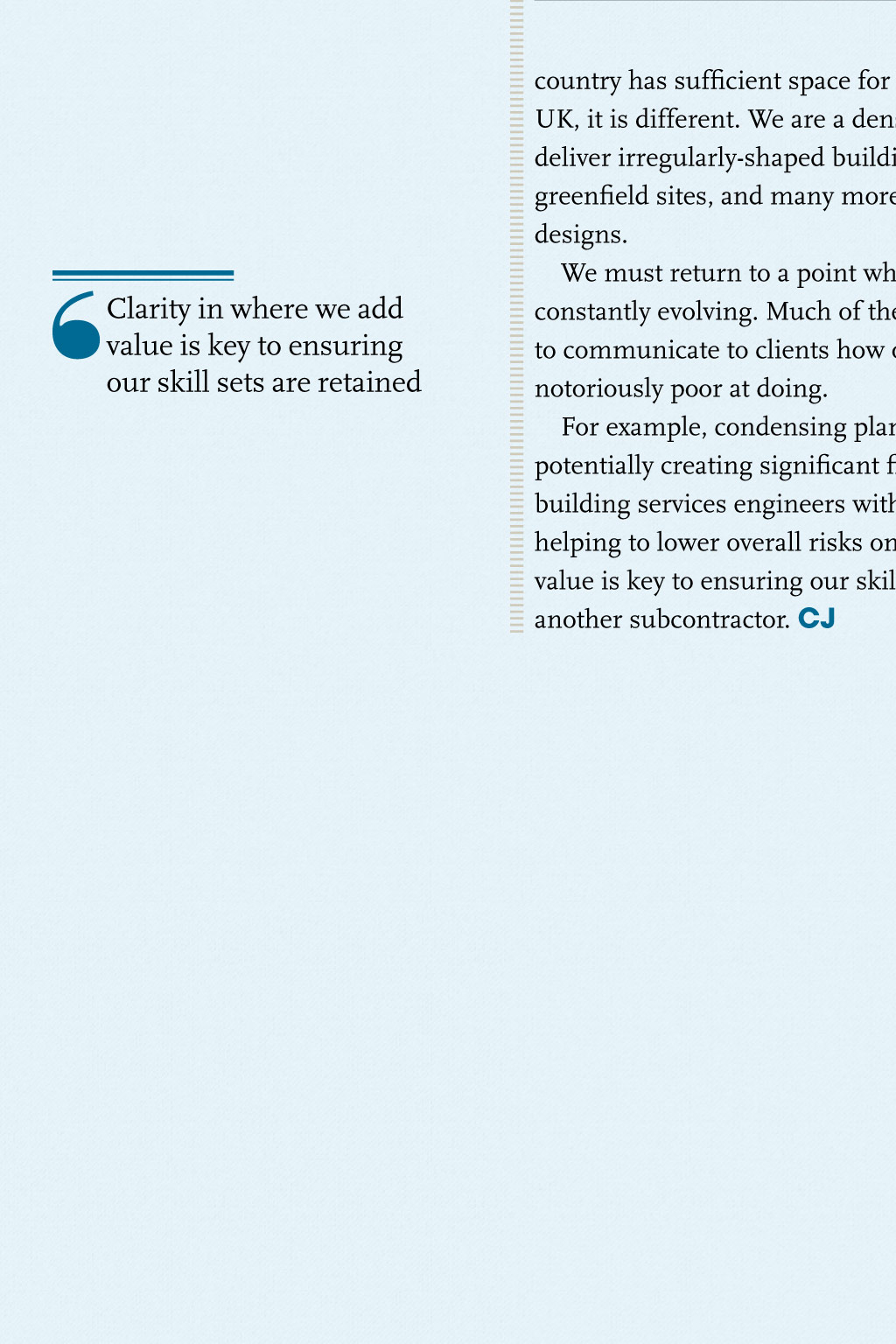












OPINION ONE-STOP SHOPS BAR INTELLIGENT DESIGN Building services skills are being overlooked by clients and contractors who increasingly value expediency over intelligent and innovative design, says Crofton Design director Marcos DeCastro Marcos DeCastro, director at Crofton Design www.crofton-design.com/ Email: london@crofton-design.com Twitter: @CroftonDesignMD Crofton Designs model of Hereford House in Kensington Clarity in where we add value is key to ensuring our skill sets are retained Building services engineers are the R&D department of the construction industry. They are innovative designers, whose skills lie in taking an overview of the systems that enable a building to function effectively, and devising complex solutions to integrate them into the building. For example, they ensure that energy efficiency measures, daylighting, and heating and ventilation systems, work in accordance with a buildings shape, floor plates and a clients budget. This requires consistent use of problemsolving, creative and visualisation skills. However, I fear that the intelligent design skills of our profession are at risk of being significantly weakened. This is primarily because many contractors now see consulting engineers as just another subcontractor. They are increasingly integrating engineering consultancies into their businesses in a quest to provide one-stop shop services to their clients. More and more, contractors and engineers are starting work on projects at the same point, simply because many engineers are now part of the contractors business. But by the time a contractor begins work onsite, its normally too late to get the best from building services design. Designing and building at the same time is tricky. If the best building services solutions are to be implemented, engineers need to explore different design concepts and decide on the right way before a contractor starts onsite. True, contractors who incorporate building services divisions into their businesses can still benefit from their design services. However, the increased pressure contractors apply because of the strict deadlines they work to often leads to elements of the building services design (for example, benchmarking compliance) being of a lower standard. It is often too simplistic, and gives little allowance for important initiatives, such as solar studies, that can improve a buildings energy efficiency and occupier satisfaction. Contractors are pushing engineers to become nothing more than process designers who deliver simple solutions as quickly as possible. This skews and confuses the industrys view of building services engineers, which increasingly sees us as the people who decide where radiators or pipework should be fitted, rather than experts who are fundamental to a projects success. We are at risk of being taken less seriously and, ultimately, seen as less valuable. When we put forward pioneering design solutions they are increasingly ignored by other members of the project team because original ideas are no longer expected from us. Industry attitudes and practices that encourage engineers not to put innovative ideas forward, will lead to younger engineers believing that their role is simpler than it should be. Of course, the issue is being exacerbated by the fact that young engineers often have less time to develop the skills to enable them to become expert at what they do. Contractors are great at procuring cheaply, managing specialists and estimating costs thats their job. They are also capable of handling building services engineering teams that deliver fully coordinated technical designs from scheme designs produced by others. However, they dont appreciate the complexities and benefits of pioneering building services design and how it should be delivered. In my view, clients and contractors need to reconsider elements of the onestop shop model. It risks hindering the industrys ability to deliver unique, quality buildings, because it places too much importance on completing projects as quickly as possible. It is predominately an American model and may work well there because the country has sufficient space for more standardised products. However, in the UK, it is different. We are a densely populated country with more of a need to deliver irregularly-shaped buildings that require a complex design. We have fewer greenfield sites, and many more constrained locations that require more creative designs. We must return to a point where building services engineers skills are constantly evolving. Much of the responsibility lies with us and our ability to communicate to clients how our design services add value, which we are notoriously poor at doing. For example, condensing plant space frees up floor area for other uses, potentially creating significant financial benefits for a developer. In addition, building services engineers with a strong grasp of BIM can add real value by helping to lower overall risks on construction projects. Clarity in where we add value is key to ensuring our skill sets are retained, and in showing we arent just another subcontractor. CJ "